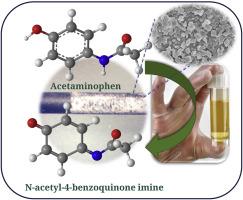Non-enzymatic ultrasensitive electrochemical detection of acetaminophen in urine using novel metal-organic framework anchored graphite rod electrode
IF 4.6
3区 工程技术
Q2 ENGINEERING, ELECTRICAL & ELECTRONIC
引用次数: 0
Abstract
Acetaminophen (AP) is used to a large extent as a pain relief drug worldwide. Now a days AP is present in high concentrations in water resources and also found in the human blood. Therefore, it is of utmost importance to detect AP for the benefit of human health. In order to obtain low-cost and highly sensitive and selective sensors for AP detection, in the present investigation, we developed a novel free-standing electrochemical sensor. We adopted the synthesis process via a facile, mild one-step solvothermal technique and developed Ni(BPDC)MOF/GRP. Inter-connected Ni(BPDC)MOF/GRP sheets provide a large external area, huge pore volume and copious reactive spots, which show extensive interactive capacity towards AP. Block-shaped MOF-anchored GRP electrode enhances electrooxidation of adsorbed AP molecules due to superior electrocatalytic properties and electronic conductivity. As-prepared MOF hybrid rod was well characterized and analyzed by various characterization practices like FTIR, Raman spectra, XRD, XPS, BET, FESEM with energy dispersive spectrometry (EDS) mapping, and HRTEM etc. The electrochemical properties of proposed hybrid electrode studied by Cyclic Voltammetry (CV), Differential Pulse Voltammetry (DPV), impedance spectroscopy and chrono-amperometry methods. The Ni(BPDC)MOF/GRP electrode exhibited a linear detection region (LDR) from 2.5 to 100 μM, a limit of detection (LOD) of 0.056 μM and limit of quantification (LOQ) of 0.169 μM. An acceptable recovery rate ranging from 95.6 % to 104.2 % was achieved by using the proposed sensor to evaluate AP in spiked human urine serum samples. Therefore, the sensor electrode offers a simple, affordable, eco-friendly, and portable solution for AP detection.

新型金属-有机骨架锚定石墨棒电极非酶超敏电化学检测尿中对乙酰氨基酚
在世界范围内,对乙酰氨基酚(AP)在很大程度上是一种止痛药。如今,在水资源和人体血液中都发现了高浓度的AP。因此,检测AP对人类健康至关重要。为了获得低成本、高灵敏度和选择性的AP检测传感器,在本研究中,我们开发了一种新型独立式电化学传感器。我们采用简单、温和的一步溶剂热技术合成了Ni(BPDC)MOF/GRP。相互连接的Ni(BPDC)MOF/GRP片提供了大的外部面积,巨大的孔体积和丰富的反应点,对AP表现出广泛的相互作用能力。块状MOF锚定的GRP电极由于优越的电催化性能和电子导电性而增强了吸附AP分子的电氧化。利用FTIR、拉曼光谱、XRD、XPS、BET、FESEM(能谱)和HRTEM等多种表征手段对制备的MOF混合棒进行了表征和分析。采用循环伏安法(CV)、差分脉冲伏安法(DPV)、阻抗谱法和计时安培法研究了复合电极的电化学性能。Ni(BPDC)MOF/GRP电极的线性检测范围为2.5 ~ 100 μM,检出限为0.056 μM,定量限为0.169 μM。采用该传感器对加标后的人尿血清样品中的AP进行检测,回收率为95.6% ~ 104.2%。因此,该传感器电极为AP检测提供了一种简单、经济、环保、便携的解决方案。
本文章由计算机程序翻译,如有差异,请以英文原文为准。
求助全文
约1分钟内获得全文
求助全文
来源期刊

Materials Science in Semiconductor Processing
工程技术-材料科学:综合
CiteScore
8.00
自引率
4.90%
发文量
780
审稿时长
42 days
期刊介绍:
Materials Science in Semiconductor Processing provides a unique forum for the discussion of novel processing, applications and theoretical studies of functional materials and devices for (opto)electronics, sensors, detectors, biotechnology and green energy.
Each issue will aim to provide a snapshot of current insights, new achievements, breakthroughs and future trends in such diverse fields as microelectronics, energy conversion and storage, communications, biotechnology, (photo)catalysis, nano- and thin-film technology, hybrid and composite materials, chemical processing, vapor-phase deposition, device fabrication, and modelling, which are the backbone of advanced semiconductor processing and applications.
Coverage will include: advanced lithography for submicron devices; etching and related topics; ion implantation; damage evolution and related issues; plasma and thermal CVD; rapid thermal processing; advanced metallization and interconnect schemes; thin dielectric layers, oxidation; sol-gel processing; chemical bath and (electro)chemical deposition; compound semiconductor processing; new non-oxide materials and their applications; (macro)molecular and hybrid materials; molecular dynamics, ab-initio methods, Monte Carlo, etc.; new materials and processes for discrete and integrated circuits; magnetic materials and spintronics; heterostructures and quantum devices; engineering of the electrical and optical properties of semiconductors; crystal growth mechanisms; reliability, defect density, intrinsic impurities and defects.
 求助内容:
求助内容: 应助结果提醒方式:
应助结果提醒方式:


